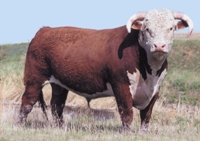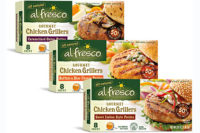
The economy may be changing consumers’ eating habits, from where they get their food to what they buy, but beef remains a staple of the American consumers’ diet. From special-occasion meals that require steaks to a quick and tasty meal of spaghetti and meat sauce or hamburgers, there remains plenty of opportunities for beef processors.
Beef processors can vary from strictly grinders to those who produce high-end steak cuts, as well as processors who customize their products to their customers’ demands. As in any part of the industry, processors are always looking for a niche to fill — that one product that they can provide to a steady market. In the beef sector, a breed-specific branded program may give that processor just such a niche.
Many consumers are content to purchase beef at restaurants or supermarkets without a care as to the breed of cattle from which the beef came. Enough of the population, though, favors the eating characteristics that only a specific breed can provide, and beef products that come from Hereford or Angus cattle have fared well in the marketplace.
One of the most familiar cattle breeds is the Angus breed, and Certified Angus Beef (CAB) has been promoting the breed for 30 years. CAB is a non-profit subsidiary of the American Angus Association.
“We’re based on the breed of Angus cattle, and the [CAB] brand takes it to a higher level by having 10 quality specifications that ensure the best eating experience each and every time,” says Tracey Erickson, vice president of marketing for CAB.
CAB works with a select group of processers/manufacturers who cover a range of products for the retail and foodservice markets. Erickson says the organization looks for processors that have similar management philosophies and are willing to promote the CAB brand as a high-quality product and not just another product offering.
“Many of our companies hang their hat on Certified Angus Beef,” she explains. “It’s their door opener, a point of differentiation at the foodservice level as well as retail. It’s something they can use to draw companies in and talk about how they’re different.”
Consumer brand loyalty
The American Hereford Association and its Certified Hereford Beef brand have a farm-to-plate approach, working with the seedstock producers, the farmers and the packers to ensure a high-quality cattle supply and beef product.“We also ensure greater demand for Certified Hereford Beef by strategic marketing, promotions and education in our customers’ grocery stores and restaurants,” says Craig Huffhines, executive vice president of the American Hereford Association. He emphasizes working with all aspects of the cattle supply chain to achieve brand success.
Huffhines acknowledges that beef is competing with lower-cost proteins, and in a weak economy, consumers are watching their spending. Consumers who do trade up to beef want a product that will give them a good overall eating experience. He says that consumers will pay more for something that is guaranteed to taste good, and the AHA has been very successful at spreading the name recognition of the CHB brand.
“It’s been our experience that after a few months of promoting the brand in the meat case, store sales begin to grow, and then consumers begin to recognize the brand,” Huffhines says. “It’s all about getting the product in the mouths in the consumer and then developing a relationship with the consumer.”
In a normal economy, Huffhines says that consumers have been willing to pay from 50 cents to $2 per pound more for CHB product versus commodity product. In the last few months, consumers have traded down from quality to lower-priced meats, the CHB program has worked to sustain reasonable premiums, with some success.
“Our more recent trends show that we are holding steady and even growing in some markets, while nationally, overall beef demand is trending flat to down,” he says.
The AHA’s reasoning for keeping Hereford-branded beef programs in retail and foodservice is that there is still quality and price inconsistency in commodity beef.
“It is not in their best interests to carry beef that may or may not reach the consumers’ expectations,” says Huffhines.
The best successes for CHB product has been in areas where retailers and restaurants have done especially well in their marketing area.
“If there is a retailer willing to go the extra mile in food safety and promotion, but also wants to provide something people will get excited about, we are interested in working with them,” Huffhines says.
Erickson says that CAB’s sales have mirrored results found throughout the meat industry, that consumers are eating out less and dining at home more. For CAB, it has translated to a significant increase in grind at the retail level, as well as an increase in middle meats.
“What that’s telling us is that while the consumer may not be able to eat out as often as they’d like or as often as they were, when they’re dining in they still want a very high-quality steak product,” Erickson explains. She notes that sales are still strong when suppliers and retailers aggressively feature the CAB brand and promote that positive eating experience, as opposed to those people who don’t believe that they can promote high-quality items at this time.
Erickson says that the target demographic for CAB product is female, 24 to 55 years old, with children and a $70,000 household income. Males are a secondary target, but she notes that 90 percent of purchases of CAB product are made by females. Overall, the demographic is one that will be willing to pay more for a premium product.
Branding and the fast-food world
While Angus beef is thought of as a high-end product, it also is becoming more and more popular in a more unlikely area.“Over the past three years, there’s been a significant push [in foodservice], and I think where the push is coming from is in the quick-service restaurants, like McDonalds, Burger King and Carl’s Jr.,” says Jamie Schweid, executive vice president of Burger Maker. Based in Carlstadt, N.J., the company is a leading supplier of burger patties and is also a licensed processor of CAB beef.
Carl’s Jr. “Six Dollar Burger” comes with a number of different toppings, but the one constant is an Angus beef patty. One of Burger King’s more recent additions is a Steakhouse Burger, featuring an Angus patty.
“We are proud of our ability to provide premium, quality products to our guests at affordable prices,” Russ Klein, Burger King’s president, global marketing, strategy and innovation, said at the time of its introduction. McDonald’s has introduced its own Angus burgers in select markets as well.
“They’ve [QSRs] been really pushing out Angus as a premier product,” Schweid says, adding that this route is the way that natural beef should take— a higher-priced, featured item, but not an outrageous price.
Brand benefits
Erickson says that processors who become licensees of the Certified Angus Beef brand get one of the most well-known brands of beef, but they also get the promotional services that come with it.“It’s an entire marketing package that we bring to the table,” she notes, adding that there is an in-house design crew that can help provide fliers or other promotional material. “We provide a lot of resources so that they can have promotions that are ready to implement.”
Wasatch Meats Inc., based in Salt Lake City, has been processing CAB product for more than 15 years, says Rich Broadbent, president. Broadbent calls the product a great niche for his company.
“I always thought that some branded items, were just a branded item, but it’s a great product,” he says. At the time when Wasatch Meats started offering CAB beef, it was a product that was relatively new to the area and it has been popular among people in the Utah resort communities.
Along with the license to process CAB beef are strict guidelines. “We have a protocol that has to be adhered to, audits and a very stringent process,” Erikson says, “to make sure they are up to par on all of the standards to ensure the product is processed correctly.”
Broadbent says that the product is purchased and broken down like commodity beef is, but the company takes care to segregate the CAB product from commodity product.
“With any branded items, we do them before we start production of anything else, so we can guarantee that it is what we’re doing, and we document that,” he said.
The breed name on the package, Huffhines says, helps to promote consumer confidence and loyalty, thanks to the accountability and product assurance that come with the name.
“Certified Hereford Beef is backed by a membership of cattlemen that care about the genetics they engineer and the product they produce,” he says. “Tremendous energy and dollars are spent developing animals that will profitably perform under harsh economic conditions to finally produce a product that will please the consumer.”



Report Abusive Comment